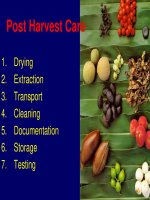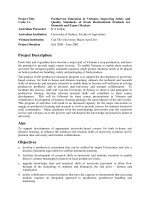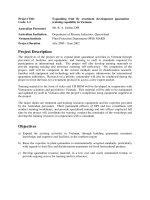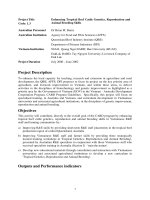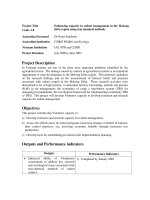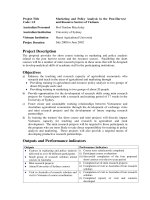Báo cáo nghiên cứu nông nghiệp " Biofertiliser inoculant technology for the growth of rice in Vietnam: Developing technical infrastructure for quality assurance and village production for farmers " pot
Bạn đang xem bản rút gọn của tài liệu. Xem và tải ngay bản đầy đủ của tài liệu tại đây (99.55 KB, 12 trang )
Project Title
Code: 1.4
Biofertiliser inoculant technology for the growth of rice
in Vietnam: Developing technical infrastructure for
quality assurance and village production for farmers
Australian Personnel
Professor Ivan Kennedy
Australian Institution
University of Sydney
Vietnam Institution
Hanoi Agri. University
Project Duration
July 2000 – June 2002
Project Description
Biofertilisers are defined in this application as microbial inoculants, isolated from
soil or the rhizosphere of plants, assisting the mobilisation of soil nutrients such as
N and P and others in the plant rhizosphere and thus promoting the growth rate and
yield of plants. Successful biofertilisers can contribute to increases in food
production in a highly sustainable manner, with economic and environmental
advantages. The extensive use of biofertilisers has the potential to better recycle the
current nutrients contained in the soils and water of agricultural ecosystems and to
reduce the negative impacts on ecosystems of chemical fertilisers.
This CARD project seeks to provide training and expertise related to quality
assurance of mother culture strains of bacteria for biofertiliser inoculants used in
paddy rice production in Vietnam. Similar quality assurance is required for
biofertilisers produced by farming communities in Vietnamese villages used to
inoculate rice seedlings. A range of techniques to identify and count inoculant
bacteria have been developed in the SUNFix Centre located at the Universities of
Sydney and Western Sydney (see attached report ACIAR project CS/1996/217).
The project will simplify, validate and further develop these procedures for routine
application in Vietnam.
Objectives
a) To establish simple microbiological and immunodiagnostic tests for providing
quality assurance of mother culture strains of bacteria for biofertiliser inoculants
used in paddy rice production in Vietnam. Similar quality assurance is required
for biofertilisers produced in the field. In addition, more specialised tests using
PCR are required to identify inoculant strains of microbes.
b) In a workshop setting, to train scientists in methods of strain selection and
quality assurance of strains in biofertilisers.
c) Field training of villagers, particularly women, in methods of biofertiliser
production and the use of simple field tests.
d) To carry out research on carrier materials for biofertilisers and methods of
ensuring high numbers of inoculant microbes in biofertilisers.
1
Outputs and Performance indicators
Outputs Performance Indicators
♦ Techniques for quality assurance
of mother cultures
i) Development of tests and protocols for
microbial strain typing such as
microbiological, immunological or
genetic (PCR) tests
♦ Field assessment of carrier
materials for biofertilizers
i) Experimental trial for comparison of
non-sterile carrier materials
♦ Training and strengthening of
Vietnamese scientists existing
knowledge on protocols for
quality assurance
i) Workshops for training of scientists
and technologists in the isolation,
counting, and identification of
inoculant strains
♦ Training of villagers in
biofertiliser production
ii) Workshops in villages given by
technologists for training of villagers
in selection of materials, production
and ensuring the good quality and
application of biofertilisers
PROJECT COMPLETION REPORT
Executive Summary
This CARD project has successfully completed the major components of its
program design. An important field trial conducted in 2001 provided unequivocal
evidence of the effectiveness of BioGro biofertiliser in giving significant yield
increases for rice. Two major technical workshops were included in the project
design to document activities (the final workshop is to be held October 9-11, 2002
in Hanoi) and several training workshops for farmers have been held in Vietnamese
villages. Methods for quality control of biofertiliser products and for field
experimentation have been developed and documented. An economic analysis for
the biofertiliser technology has been completed, clarifying the economic and social
advantages possible from its application. A field study aiming to document farming
practice during successful application of biofertiliser has also been completed for
rice farms in north Vietnam. A Quality Control Manual is published at the final
workshop in October 2002. The performances of personnel from the University of
Sydney and the Hanoi University of Science have met expectations, although not all
projected activities could be completed because of factors beyond our control.
1. Project Description
1.1 Background and preparation
Biofertilisers are defined in this application as microbial inoculants, isolated from
soil or the rhizosphere of plants, which assist the mobilisation of soil nutrients such
as N and P in the plant rhizosphere and otherwise promote the growth rate and
2
yield of plants. Successful biofertilisers should contribute increases in food
production in a sustainable manner, with economic and environmental advantages.
The extensive use of biofertilisers has the potential to better recycle the current
nutrients contained in the soils and water of agricultural ecosystems and to reduce
the negative impacts on ecosystems of chemical fertilisers.
This CARD project sought to provide training at several levels and expertise related
to quality assurance of starter culture strains of bacteria for biofertiliser inoculants
used in paddy rice production in Vietnam. Similar quality assurance is required for
biofertilisers produced by farming communities in Vietnamese villages. A range of
techniques to identify and count inoculant bacteria needed to be developed at the
Universities of Sydney and Western Sydney. The project aimed to simplify,
validate and further develop these procedures for routine application in Vietnam.
The need for quality assurance had been identified in a previous small ACIAR
project and it was the main aim of the CARD project to provide this. Such quality
assurance is considered to be needed in producing commercial products and for
their effectiveness in the field. The main beneficiaries of the improved technology
are rice farmers, who obtain improved yields of rice and more income and the
workers in village factories producing the biofertilisers, as a result of more reliable
technology.
1.2 Context and rationale
The current context for biofertiliser production involves a 3 - stage process. Strains
of micro -organisms selected for their effectiveness biological nitrogen fixation,
phosphate mobilisation and plant-growth promotion - PGPR are cultured in
fermentors as pure cultures at the University of Hanoi by Professor Hien’s staff.
Three of these strains are then added separately to a peat carrier to be transported to
factories located in villages in the field. Field staff in these factories then multiply
about 80 - fold the cultures separately in a two stages in peat to which rice husks
and sugar are added and the final inoculant biofertiliser product (BioGro, see
attached brochure). The BioGro product is then transferred to farmers while fresh
and used to inoculate rice seedlings in paddies at transplanting.
The CARD project was based on a small ACIAR research project that had
previously established the probable validity of applying biofertilisers to rice. There
is interest in obtaining such products for application in Vietnam, but no other case is
known to me of such extensive application in the field on farms. The CARD
project has adopted a more-production oriented approach and has included an
economic analysis to test the validity of the technology. This is innovative
technology that has no counterpart in Vietnam or other countries, although there is
great interest in the development of such technology (see RIRDC book,
Biofertilisers in Action). In this sense, this is a landmark project that could provide
an essential stimulus to more widespread application of biofertiliser technology.
There are important environmental advantages as well as economic advantages
3
possible using the technology if it can be shown to be a viable process. To further
stimulate this process, it is anticipated that a new large ACIAR project may be
initiated, to provide supporting strategic research to help optimise the technology.
The design of the project was decided by the nature of this 3 - stage process.
Although the project could have been pursued in different ways, the options chosen
(technical and field training workshops, supporting research on development of
quality control procedures) were based on the need to help guarantee the success of
the technology and to reduce the risk of failure. A considerable network of
participants was involved in Vietnam, including the Women’s Union (see attached
English translation of the BioGro brochure developed during the project).
1.3 Project objectives and scope at design
The main objectives and inputs are:
To establish simple microbiological and immunodiagnostic tests for providing
quality assurance of biofertiliser mother cultures and for biofertilisers produced in
the field. In addition, more specialised tests using PCR are required to identify
inoculant strains of microbes
In a workshop setting, to train scientists in methods of strain selection and quality
assurance of strains in biofertilisers.
Field training of villagers, particularly women, in methods of biofertiliser
production and the use of simple field tests.
To carry out research on carrier materials for biofertilisers and methods of ensuring
high numbers of inoculant microbes
The measurable outcomes were expected to be:
The training of teams of Vietnamese scientists and teachers in methods needed for
effective biofertiliser production
The development of a new village industry generating cash flow for village women
A cleaner agricultural environment producing more rice for home and export
consumption at lower input costs
Significant progress towards achieving these objectives has been made, although
much remains to be done and the area may represent a major opportunity for
effective investment in future.
These objectives are considered to be strongly consistent with AusAID’s country
objectives, and partner government programs in proposing an innovative approach
to developing rural industry infrastructure aiming to develop a more sustainable
production system. Women play a particularly strong role in this project as
scientists and technicians, village producers and farmers. The project also has a
positive environmental impact, possibly reducing global warming by improving the
efficiency of utilisation of nitrogen as a crop nutrient.
4
1.4 Implementation arrangements
The implementation of the project has been quite smooth, without significant
administrative problems. Good communications had already been established
during the previous ACIAR project. Only one university centre was primarily
involved in each country. Nevertheless, the availability of email communication
has been essential to the project allowing information exchange to occur almost
immediately in only a day or two. The availability of Dr Rodney Roughley as an
Honorary Associate of the SUNFix Centre for Nitrogen Fixation to participate in
the project in Vietnam has been most fortunate. His years of experience with
national quality assurance for Rhizobium in Australia have also provided a strong
boost to this CARD project and for the development of the Quality Control Manual
to be completed in Oc tober. Dr Roughley has supervised the field trials in Vietnam
and t he collection and analysis of data from farmers regarding on - farm trials of
BioGro. Administrative staff at both universities have been cooperative and
supportive of the activity.
2. Appropriateness of Project Design and Objectives
2.1 Appropriateness of Objectives
Objecti
ve No
Objective description Appropriateness
Rating
1. Development of techniques for quality assurance of mother
cultures and of simple tests for field inoculant biofertilisers
for rice produced by villagers, using microbiological,
immunological and genetic (PCR) approaches.
4
2.
(Revise
d)
Field trial in Viet Nam to determine the need and optimum
level of farm-yard manure for positive effects from
biofertiliser inoculants. [Greenhouse trial in Australia at
BioCare Technology to compare results using sterile carrier
(gamma-irradiated) with those using non-sterile media (peat
or organic soil) as used at present in Vietnam. Not
performed because of delays in preparing the case to obtain
permission from AQIS to use inoculant strains elsewhere
than the University of Sydney.]
4
3. Workshops to teach scientists and technologists in
Vietnamese institutions techniques of biofertiliser production
and quality assurance.
4
4. Training by technologists instructing village women and
others in biofertiliser production, sampling for simple tests of
quality and methods for field application.
4
5
2.2 Appropriateness of Design
Description of design feature Appropriateness
Rating
Two technical Workshops for scientists in Hanoi to define project
methods and to produce documented manuals and a Quality Control
Manual
4
Research in Australia, to identify strains using molecular (ribosomal
RNA, PCR) and determinative (Bergey’s) techniques, to develop
methods for quality control (antibiotic resistance, ELISA tests from
antibodies to strains, colony DNA-probe blotting, nutritional tests, etc.)
3
Research in Viet Nam, to isolate new strains, to verify positive effects
on crop yields using field trials with replicated plots and split plots on
individual farms
4
Economic research in Viet Nam (Barrett and Marsh), including field
assessment of the technology
4
5- Best Practice; 4- Fully Satisfactory; 3- Satisfactory overall; 2- Marginally
Satisfactory; 1- Weak
3. Implementation Performance
3.1 Project Components and Outputs
Component
No.
Component Description Outputs Performance
Indicators
Performan
ce Rating
1 Develop test methods
and train methods for
quality control
PCR tests for
identification of
mother culture
strains,
immunodiagnostic
tests and DNA blot
tests completed
Four tests
developed as pilot
methods for five
microbial strains
4
2 Produce good quality
biofertiliser mother
cultures for field trials
with rice crops.
Replicated field
trials and split farm
trials
One field trial, 60
farmer trials
4
3 Training of Vietnamese
scientists and
technologists in
techniques of
Technical training
workshops
Two technical
workshops (June
2001, October
2002), training
4
6
biofertiliser production
with adequate quality
control and quality
assurance.
more than 20
scientists
4 Training of village
women in techniques of
biofertiliser production
Field training
workshops
Six field
workshops
training of 400
villagers and
farmers (see
attachment from
Hien)
4
5: Exceeding time and quality targets, 4: Achieving time and quality targets and on
budget; 3: Moderate progress towards targets, some issues about quality, budgets or
costs but these are being adequately addressed; 2: Some progress towards targets,
but slippage in schedule and cost overruns; & 1: Significant problems in achieving
targets, quality outputs unlikely to be achieved and substantial cost increases
affecting overall budget.
Apart from minor changes regarding implementation of methods, only one major
approved change was made during the project. This was to gain approval to delay
the final workshop to avoid clashes with busy periods in biofertiliser starter culture
production, harvests and the hot season. This will be held in mid-October, 2002,
when the final outputs of the project will be delivered. This variation will prove
beneficial, allowing more time for test development and preparation of the Quality
Control Manual, the main output of the project. A Supplementary Report will be
prepared for AusAID in mid - October.
A major factor affecting the implementation of the project in a positive sense was
the highly effective network in rice-growing rural areas established by Professor
Hien over the past ten years. Another factor was the strong commitment of the
Vietnamese team to obtaining results in the field. This provided a complementary
opportunity for the Australian team to carry out supporting research relying on
facilities and expertise available in Australia but not in Vietnam.
3.2 Project Outcomes
The main outcomes of the project include:
Confirmation of the effectiveness of inoculant biofertiliser (BioGro) in field trials
(documented in Nguyen, Roughley and Kennedy, 2002, in Biofertilisers in Action,
attached).
Confirmation of the effectiveness of BioGro in farmer trials (documented in
Nguyen et al., 2002).
7
Identification of inoculant strains of bacteria (documented in Workshop 1 Manual
(previously submitted) and Workshop 2 Manual (in preparation, see programme
attached as Appendix 2)
Economic assessment of biofertiliser (documented in Barrett and Marsh, 2002, in
Biofertilisers in Action, attached)
3.3 Sectoral Impact
This project was mainly carried out by Vietnamese women, with a ratio of female to
male participants in the project of more than 2 to 1. The majority of the staff
producing biofertiliser in the project were women and the Vietnam Women’s Union
played a strong role in providing acceptance of the technology by farmers, many of
whom were also women. The field trial was established and harvested solely by
women. Concern of such community groups for better environmental outcomes was
also a factor in acceptance of biofertiliser technology. The generation of additonal
cash flow in villages is a potential advantage of this technology, compared with the
importation of chemical fertilisers, often assisting household budgets particularly
for women.
3.4 Costs and Financing
The budgeted costs for the project design approximately matched expenditure
within 95%, both in Australia and in Vietnam, as shown in the acquittal in the
Appendix A1.0. However, about $10,000 cash over-expenditure is anticipated by
the completion of the project in October because of additional costs in achieving
objectives at the University of Sydney and expenses incurred for the October
Workshop 2. This over - run was largely a result of the need to employ new
research staff and for un-budgeted technical assistance in the project period, leaving
the Workshop largely unfunded.
3.5 Monitoring of project
The project directors have been responsible for overall project monitoring, together
with periodic discussion (e.g. see Trip Reports by Australian participants visiting
Vietnam). They were assisted by University staff including accountants.
Institutional contributions were assessed using standard estimates of in-kind
support. The Faculty also supplied administrative support (Ms Annette Vervoort)
who assisted with six - monthly reporting required to be sent to the University of
Wollongong. These arrangements allowed sufficient indication that milestones
were being met more or less on schedule.
However, relatively little feed-back was received during the project, in contrast to
projects funded from other sources (e.g. ACIAR). An advantage of this was that the
time for project activities could be focussed on carrying out the project design. A
request was made to receive feed-back from a review of the project conducted for
AusAID in Vietnam in 2001. However the advice received was that this review
was for AusAID’s use only. I am of the opinion that this may have represented a
8
missed opportunity for project improvement, judging from some comments made
by our Vietnamese colleagues.
3.6 Technical Assistance, Training and Capacity Building
Capacity building has involved the generation of quality control methods for
application in Vietnam as well as in increased proficiency of participating staff. The
working relationship between both institutions has been very good with no time
lost on this account. Capacity building has occurred as a result of (i) training of
new staff at both institutions and of many field workers in Vietnam. (ii) technical
developments providing greater convenience in the identification and quantification
of microbial strains, from work in both Vietnam and Australia. (iii) published
material as outcomes of the project (see 4 papers in Biofertilisers in Action attached.
There were some difficulties in retaining essential staff in work in Australia. The
Vietnamese team of about six scientists at the Biofertilizer Laboratory (HUS) was
more stable in composition.
The training activities including technical workshops and field workshops help
provide a working structure for work of this kind, assist in establishing networks
and assessing acceptance of the biofertiliser technology. They are considered to be
essential components and this opinion was re-inforced during the project.
3.7 Management of Constraints, Issues, Risks and Change
A smooth working relationship was already established between the Biofertiliser
Laboratory at Hanoi University of Science and the SUNFix Centre for Nitrogen
Fixation at the University of Sydney. The advantage of the participants being well
known to each other and frank in discussions has helped avoid serious constraints or
significant issues developing during the project. Kennedy and Roughley from the
University of Sydney made ten visits to Viet Nam, generally at separate times
(except during the two technical workshops), thus magnifying the interface for
interaction and allowing independent assessments of progress in the project, while
Hien made a single visit to Australia to participate in the 8
th
International
Symposium on Nitrogen Fixation with Non-Legumes. Some current difficulties at
the Ba Vi biofertiliser production facility are still being resolved, but it is
anticipated that discussion and analysis at Workshop 2 in October will provide
useful information regarding the eventual acceptance of this technology.
3.8 Project Management
As Project Director, I consider that promised commitments of in -kind support from
the University of Sydney have been satisfactorily met. Changes in staff personnel
(e.g. departure of Dr Nirmala Gunupala) have cause some inefficiency but
satisfactory substitutes have been found (e.g. Dr Misi Kecskes). We have met all
projected milestones.
Professor Nguyen Thanh Hien has shown herself to be a very capable cooperator in
this project. Her staff and her contacts with the rice farming industry have proved
9
to be very effective. The Vietnam Women’s Union has provided her with effective
support. She has a reputation for achieving practical outcomes and we have been
fortunate. However, some proposed arrangements within Vietnam have foundered
(e.g. a sugarcane trial proposed in the February 2002 Report failed because
promised support from a producer did not eventuate). I would rate Professor Hien
’s performance as Fully Satisfactory (4), although it is not evident that the Hanoi
University of Science should take major credit for this other than their support at
Workshops. This project is driven by her enthusiasm and experience. Activity by
the Hanoi University of Science group is strongly oriented towards field application
of the technology, the University providing an umbrella for this activity. There has
been only a minor impact on teaching within the university from this project since
teaching is not its focus.
5: Best Practice; 4: Fully Satisfactory; 3: Satisfactory Overall; 2: Marginally
Satisfactory; 1: Weak.
4. Performance and Outcomes
4.1 Assessment of Performance Against Objectives and Design
We consider that the project has been successful regarding outcomes well within
expectations. Significant progress has been made in the development of quality
assurance. The stage is set for further advancement. It should be noted that the use
of inoculant biofertilisers is not universally favoured in Vietnam. Rather official
Government agencies within Vietnam have encouraged chemical fertiliser
production and cheaper fertiliser imports are also available. This provides strong
competition for the development of biofertiliser technology, sometimes encouraged
by cash flow support. However, we consider poverty reduction as a goal may be
better served by biofertiliser technology, since it involves reduced inputs and can
improve the effeciency of use of chemical fertilisers. In a freer market, GOV
research and development priorities should increasingly favour such developments,
given that there are also environmental benefits. The project is very well aligned
with CARD program objectives, aimed at providing infrastructure for innovative
technology directly aimewd at rural development. At this stage, there is no direct
GOV involvement, although MARD and the Plant Protection Department have
expressed intrerest in attending the final Workshop in October.
4.2 Sustainability
A rating of 3, Satisfactory Overall, is suggested as appropriate. As an innovative
technology, it seems that commercial independence for the technology is not yet
feasible, although the activity of Mr Nguyen Thoan, an entrepreneur now operating
two factories, suggests that such independence may emerge soon.
However, there will be a need to encourage financial interest and to provide
strategic research support during the next ten years if the technology is to become
10
self - sufficient. A major expansion phase is now desirable. Women are prominent
in this activity and gender sustainability regarding their participation is not an issue.
5: Best Practice; 4: Fully Satisfactory; 3: Satisfactory Overall; 2: Marginally
Satisfactory; 1: Weak.
4.3 Development Impact
With effective support, this technology has the potential to expand many hundreds
of times in Viet Nam and elsewhere (see Biofertilisers in Action). This may be the
case in ten years time. We propose that this process should be strongly fostered and
are using the outcomes of this project to support such a future impact. We have
applied for an ARC Linkage grant with Bio - care Technology and Yates Seeds for
development of similar technology for rice and turf grass in Australia. If this
occurs, this CARD project will have been a key component in this development.
5. Conclusions
5.1. Overall assessment
The project design specified achievements related to (i) training of personnel in
biofertiliser starter production and in villages where c ommercial product is made;
(ii) the development of new tests for quality control were also specified as well as,
(iii) confirmation that biofertilisers were effective. All these objectives have been
achieved. Nevertheless, there is still much to be done and the achievements are
limited. Only a pilot stage has been the substantial outcome. There is a need for
more effective and convenient quality control methods that can be directly used by
farmers and villagers with minimal training. Work in Australia using sterilised
peat was not carried out because of a need to ensure safety in introducing
Vietnamese strains of bacteria to Australian ecosystems. Extension of the
technology to sugarcane in Vietnam also failed to be achieved.
It is difficult to speculate on how a different project design could have improved
the scale of achievements.
It seems obvious that effective business plans for development of this technology
will be required, together with a suitable scale of capital investment. We intend to
investigate these possibilities at the October technical Workshop 2 and will be
inviting participation by organisations such as ADB and JICA.
5.2. Lessons Learned
This project has demonstrated that introducing innovative solutions will always cost
a lot in human commitment. The continued enthusiasm and even faith exhibited in
the eventual success of biofertiliser technology by Professor Hien is an essential
feature of this project. Similarly, the Australian participants, as a result of the
success they have enjoyed using legume seed inoculant of Rhizobium, have been
driven by a strong desire to give this technology with such potential for huge
success in the long run to be fairly assessed. There is a significant international
11
effort with a similar purpose but there are few cases of such concerted action in the
field as in this project. Technical lessons learnt emphasise the need for very simple
methods that are inexpensive to apply and applicable by people with limited
technical training. The funds requested for this project were modest but
commensurate with available committed resources.
12


